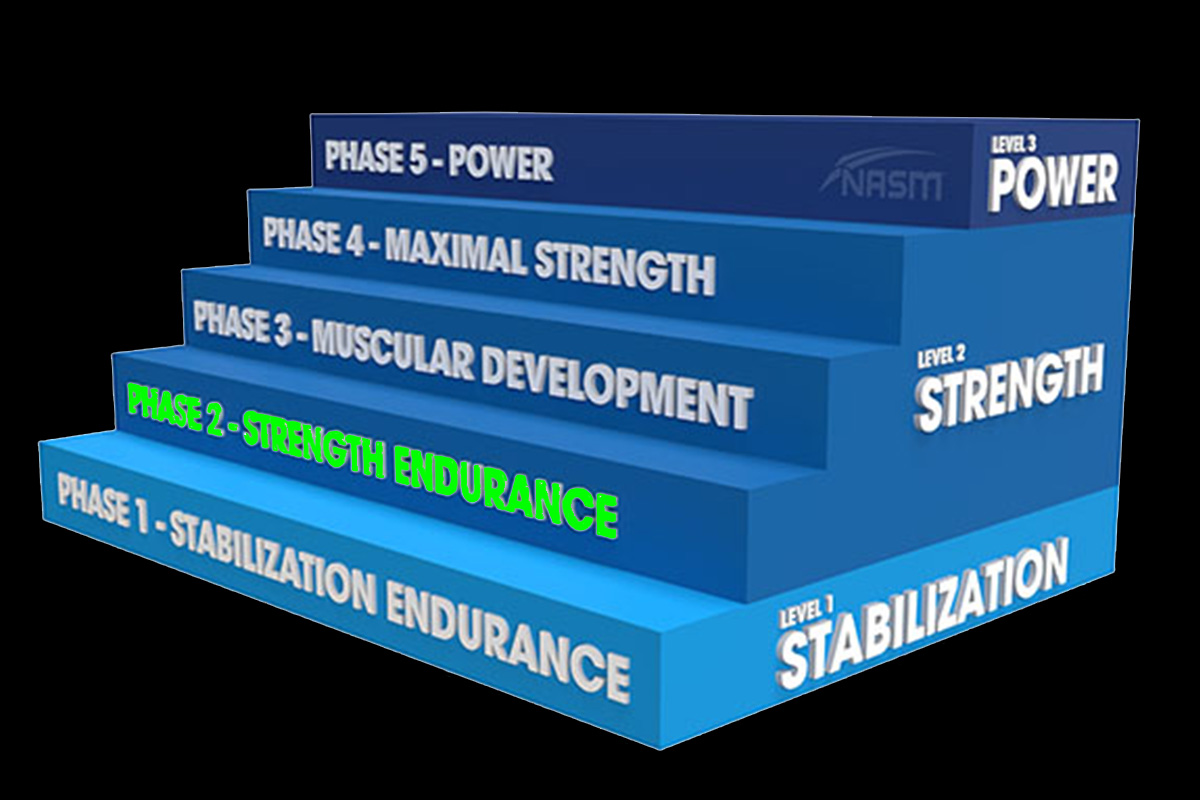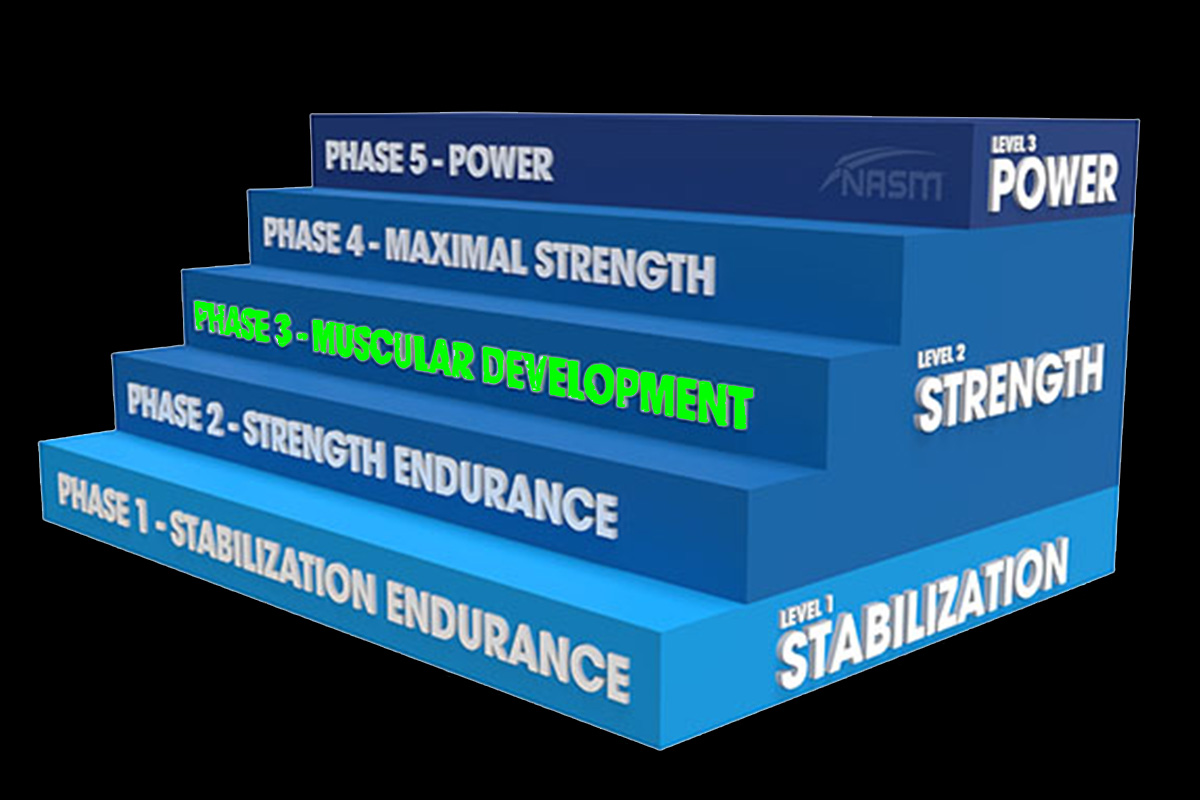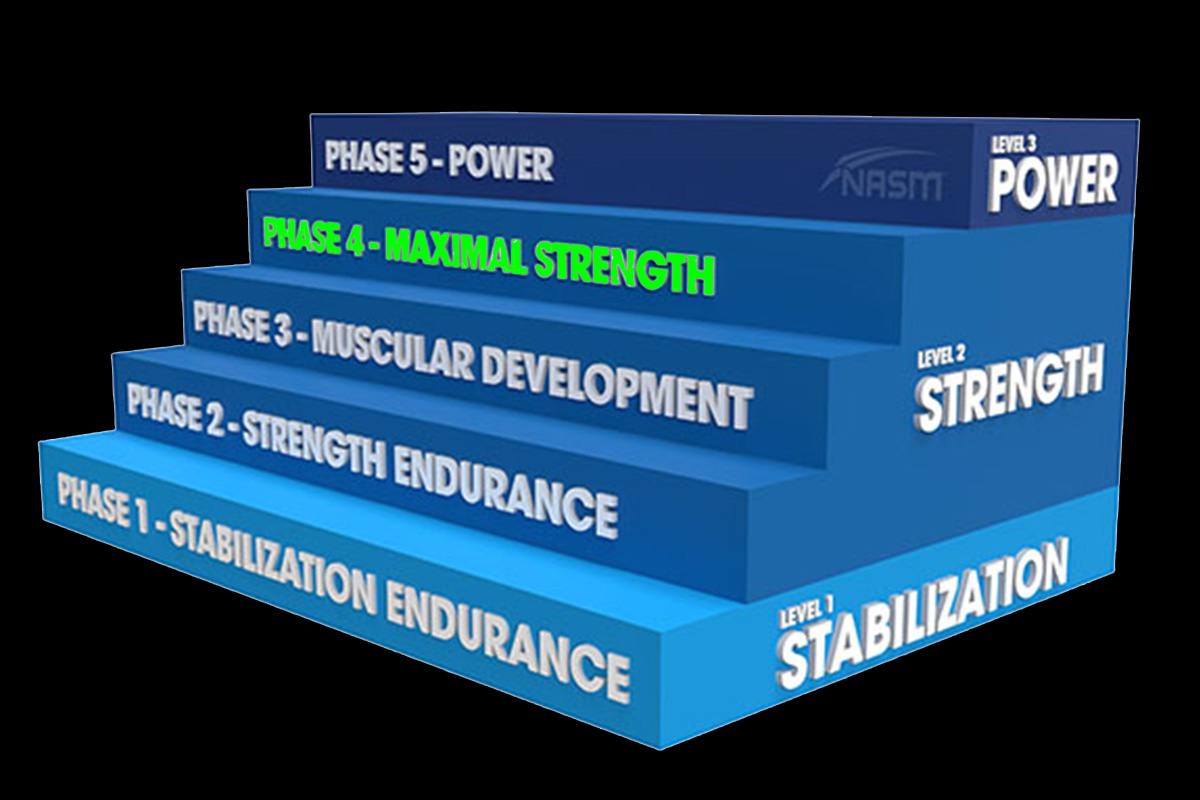Fitness is not a one-size-fits-all affair and understanding the nuances of structured exercise is crucial for achieving your goals. One popular and comprehensive model is the National Academy of Sports Medicine’s Optimum Performance Training (OPT) model, commonly known as the NASM pyramid. This system provides a balanced and systematic approach to strength training, prioritising safety and effectiveness.

This article will break down the five phases of the NASM pyramid. Whether you’re a seasoned fitness professional, a fitness enthusiast or a novice, this detailed guide will aid you in understanding the pyramid’s structure and the specific exercises to help implement each phase.
Phase 1 of the NASM pyramid: Stabilisation endurance

Embarking on the fitness journey starts with a single step. For the NASM pyramid, this step is the stabilisation endurance phase. Here, your goal is threefold.
First, you aim to develop muscular endurance. This means training your muscles to work for extended periods.
Secondly, you target core stability. A stable core is vital. It maintains body alignment and balance during workouts.
Lastly, you strive to improve flexibility. This attribute increases your range of motion. Also, it reduces the risk of injuries.
Exercise selection for stabilisation endurance training in the NASM pyramid
Let’s now turn to choosing exercises. In this phase, your workout should focus on full-body exercises. These exercises activate stabiliser muscles and test your balance.
Some exercises come to mind. For instance, consider squats with a stability ball or lunges. These exercises engage many muscles at once. They also challenge your balance.
Then, there are single-leg balance exercises. They improve your balance and core stability.

Lastly, try using a BOSU ball. This equipment is quite versatile. You can perform a wide range of exercises on it. It creates an unstable surface. This challenges your balance and engages your core muscles.
Training variables for stabilisation endurance training
Now, let’s talk about training variables.
First, we have intensity. In this phase, aim for 50-70% of your maximum heart rate. This intensity allows you to perform more repetitions.
Secondly, we have volume. Aim for 12-20 repetitions for each exercise. Perform one to three sets.
Finally, pay attention to tempo. Your movements should be controlled. This helps maintain correct form and stability.
In conclusion, Phase 1 of the NASM pyramid is crucial. It acts as the foundation for your fitness journey. It ensures you are ready for the challenges of the subsequent phases. Remember to focus on muscular endurance, core stability and flexibility. Choose exercises that activate stabiliser muscles and challenge your balance. Lastly, aim for 50-70% of your maximum heart rate and maintain a controlled tempo.
Phase 2 of the NASM pyramid: Strength endurance
The ascent up the NASM pyramid brings us to the second stage. We call this the Strength Endurance phase. At this stage, your goal is to enhance your strength endurance. This means improving your body’s ability to exert force over longer periods.

Achieving this goal has a two-fold benefit. Firstly, it aids your everyday activities. Think about it. Carrying shopping bags or moving furniture becomes easier. You can perform these tasks longer without tiring.
Secondly, it helps you in sports. In games like football or tennis, strength endurance is crucial. It lets you maintain your performance throughout the game.
Exercise selection for strength endurance in the NASM pyramid
The exercises you choose at this stage should reflect your goal. You need a unique combination of exercises. You’ll perform a traditional strength exercise followed by a stabilisation exercise. This combination targets both strength and endurance.
Let’s give an example. Start with a set of bench presses. This is your strength exercise. It works major muscle groups and helps build strength.

Right after the bench press, do a set of stability ball push-ups. This is your stabilisation exercise. It trains your muscles to maintain force production, even when fatigued.
This combination of exercises offers unique benefits. It’s a time-efficient way to train both strength and endurance.

Training variables for strength endurance
Now, let’s talk about training intensity. For this phase, aim for 70-80% of your maximum heart rate. This intensity is higher than in Phase 1. It reflects the increased demands of the strength exercises.
Next, consider volume. You should aim for 8-12 repetitions per exercise. Perform two to four sets of each. This range offers the right balance between strength and endurance training.
Finally, think about rest periods. Rest for one minute between sets. This short rest period ensures your muscles stay under tension for longer. It stimulates strength endurance adaptations.
To sum up, Phase 2 of the NASM pyramid is about strength endurance. It’s about improving your ability to exert force over extended periods. The exercise selection combines strength and stabilisation exercises. The intensity is higher, reflecting the need for greater force production. The volume and rest periods aim to strike a balance between strength and endurance. With these strategies, you’re on your way to achieving superior strength endurance.
Phase 3 of the NASM pyramid: Muscular Development/Hypertrophy
As we continue our ascent up the NASM pyramid, we find ourselves at the midpoint. This stage is the Muscular Development or Hypertrophy phase. The focus here? Muscle growth.

This stage is an exciting one. It’s where you start to see visible changes in muscle size. It’s where your workouts start to sculpt your body. Whether you’re a budding bodybuilder or someone seeking a lean, toned look, this phase is crucial.
Exercise selection for muscular development/hypertrophy in the NASM pyramid
At this phase, the exercise spotlight shines brightly on traditional strength training. It’s these exercises that stimulate your muscles to grow.

Your routine will include a mix of exercises. You’ll perform compound movements. Think deadlift and squats. These exercises work multiple muscle groups at once. They’re efficient and effective at promoting growth.
Additionally, your routine will feature isolation exercises. Examples include bicep curls and calf raises. These exercises focus on a single muscle group. They’re perfect for emphasising specific muscles.

Training variables for muscular development/hypertrophy
With exercises chosen, let’s consider training variables.
First, think about volume. In this phase, aim for a high volume of work. This means performing 6-12 repetitions for three to five sets. This high-volume approach stimulates your muscles to grow.
Next, consider intensity. You should aim for moderate intensity. This equates to about 75-85% of your maximum capacity.
Finally, don’t forget rest periods. Rest for 0-60 seconds between sets. This short rest period keeps your muscles under tension. This stimulates further muscle growth.
In summary, the hypertrophy phase of the NASM pyramid is all about muscle growth. It’s about enhancing your physical appearance and increasing your strength. It’s about crafting the body you want. And with the right selection of exercises and training variables, you’ll be well on your way. So, keep pushing, keep growing and remember: the top of the pyramid is not too far off!
Phase 4 of the NASM pyramid: Maximal Strength
As we ascend to the fourth layer of the NASM pyramid, the air grows thinner, but the determination is stronger. This is the Maximal Strength phase. The name says it all. At this point, we’re aiming for peak power, pushing our strength to the absolute limit.

This phase is a draw for many. If you’re an athlete in power sports, this is your bread and butter. But it isn’t only for athletes. For the average fitness enthusiast, it’s an exciting challenge. It’s a chance to see just how strong you can be.
Exercise selection for maximal strength in the NASM pyramid
So, what exercises lead to maximal strength? Compound movements are the stars of this phase. They engage multiple muscle groups, leading to greater strength gains.

Consider deadlifts, a whole-body exercise that particularly targets the lower body. Then there are squats, renowned for building leg and core strength. Bench presses, too, are invaluable, building your chest and arm strength. Lastly, don’t forget shoulder presses. They’re excellent for upper body strength.
Training variables for maximal strength
With our exercises chosen, let’s shift focus to training variables.
Firstly, let’s look at intensity. At this stage, we’re not playing games. Intensity is at the top end of the scale, at 85-100% of your maximum capacity.
Volume is another key variable. The aim here is to perform 1-5 repetitions for four to six sets. With such a high intensity, the number of repetitions is fewer. This approach allows you to focus on lifting as much weight as possible while maintaining good form.
Lastly, don’t forget about rest. Between sets, rest for 3-5 minutes. This allows your muscles to recover enough for the next set, ensuring you can keep pushing those heavy weights.
In summary, Phase 4 of the NASM pyramid is a powerful phase. It’s where you test your strength boundaries. It’s where you discover just how much you’re capable of. So whether you’re an athlete or a fitness enthusiast looking for a challenge, this phase is for you. Remember, keep lifting, keep pushing and embrace the power of strength.
Phase 5 of the NASM pyramid: Power
Here we are, at the summit of the NASM pyramid. This pinnacle phase is all about power. Power is the product of strength and speed. It’s about exerting maximal force in the shortest possible time.

This phase is fundamental for many athletes. If your sport requires explosive movements, then you’re in the right place. Think sprinters surging off the starting blocks. Picture weightlifters hoisting heavy loads overhead with speed and precision. It’s all about power.
Exercise selection for power in the NASM pyramid
Selecting the right exercises for this phase is a balancing act. It’s about marrying strength and power in a single workout. Here’s how it works.
First, you’ll perform a strength exercise. This might be a heavy barbell squat. It’s an exercise that challenges your muscles to their maximum. It’s about building and maintaining raw strength.

Immediately after your strength exercise, you switch to a power exercise. For instance, you could follow your barbell squat with a set of squat jumps or box jump. The same muscles that were straining under the weight of the barbell are now exploding into a high-speed action.

This blend of exercises is perfect for building power. The strength exercises lay the foundation. The power exercises then teach your muscles to use that strength quickly and explosively.
Training variables for power
Now, onto the training variables. Remember, this phase is all about speed and strength.
Start by considering the weight. For power exercises, you’ll be using a lighter load. Aim for about 30-45% of your one-repetition maximum. Why so light? Well, it’s about speed. A lighter weight allows you to move faster, teaching your muscles to apply force quickly.
For the strength exercises, it’s a different story. Here, you should be lifting heavy. Aim for 85-100% of your one-repetition maximum.
Next, think about volume. Aim for 1-5 repetitions per set. This low volume ensures you can focus on producing maximal force with each repetition. You should aim for three to five sets in total.
Finally, rest is crucial at this stage. Rest for 3-5 minutes between sets. This gives your muscles a chance to recover, so you can hit the next set just as hard.
In conclusion, Phase 5 of the NASM pyramid is all about power. It’s the culmination of your hard work. It’s where you combine the strength you’ve built with the speed you’ve developed. This is the peak of the pyramid and it feels good to be on top. Whether you’re an athlete or a fitness enthusiast looking to push boundaries, this phase is for you. Now, go forth, be powerful and remember: the only limit is the one you set yourself.
Conclusion
The NASM pyramid offers a comprehensive approach to fitness training, covering all bases from stability and endurance to strength and power. Whether you’re a fitness professional looking for a systematic training method or a fitness enthusiast wanting to step up your game, the NASM pyramid provides the framework you need.
Don’t hesitate to reach out if you have any questions or need personalised advice based on the NASM pyramid. Remember, the journey to fitness is not a sprint but a marathon. Embrace the process, respect each phase and keep pushing forward.
Do you want to get the most out of your training? The NASM pyramid could be the answer. Start today and see the benefits unfold as you ascend each level. The peak is closer than you think.
